AMD's Radeon HD 5870: Bringing About the Next Generation Of GPUs
by Ryan Smith on September 23, 2009 9:00 AM EST- Posted in
- GPUs
Cypress: What’s New
With our refresher out of the way, let’s discuss what’s new in Cypress.
Starting at the SPU level, AMD has added a number of new hardware instructions to the SPUs and sped up the execution of other instruction, both in order to improve performance and to meet the requirements of various APIs. Among these changes are that some dot products have been reduced to single-cycle computation when they were previously multi-cycle affairs. DirectX 11 required operations such as bit count, insert, and extract have also been added. Furthermore denormal numbers have received some much-needed attention, and can now be handled at full speed.
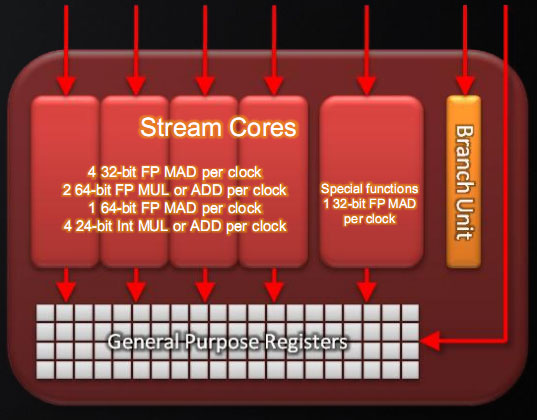
Perhaps the most interesting instruction added however is an instruction for Sum of Absolute Differences (SAD). SAD is an instruction of great importance in video encoding and computer vision due to its use in motion estimation, and on the RV770 the lack of a native instruction requires emulating it in no less than 12 instructions. By adding a native SAD instruction, the time to compute a SAD has been reduced to a single clock cycle, and AMD believes that it will result in a significant (>2x) speedup in video encoding.
The clincher however is that SAD not an instruction that’s part of either DirectX 11 or OpenCL, meaning DirectX programs can’t call for it, and from the perspective of OpenCL it’s an extension. However these APIs leave the hardware open to do what it wants to, so AMD’s compiler can still use the instruction, it just has to know where to use it. By identifying the aforementioned long version of a SAD in code it’s fed, the compiler can replace that code with the native SAD, offering the native SAD speedup to any program in spite of the fact that it can’t directly call the SAD. Cool, isn’t it?
Last, here is a breakdown of what a single Cypress SP can do in a single clock cycle:
- 4 32-bit FP MAD per clock
- 2 64-bit FP MUL or ADD per clock
- 1 64-bit FP MAD per clock
- 4 24-bit Int MUL or ADD per clock
- SFU : 1 32-bit FP MAD per clock
Moving up the hierarchy, the next thing we have is the SIMD. Beyond the improvements in the SPs, the L1 texture cache located here has seen an improvement in speed. It’s now capable of fetching texture data at a blistering 1TB/sec. The actual size of the L1 texture cache has stayed at 16KB. Meanwhile a separate L1 cache has been added to the SIMDs for computational work, this one measuring 8KB. Also improving the computational performance of the SIMDs is the doubling of the local data share attached to each SIMD, which is now 32KB.
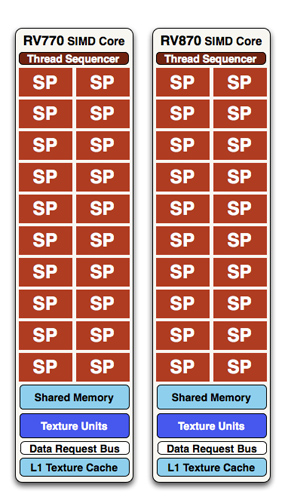
At a high level, the RV770 and Cypress SIMDs look very similar
The texture units located here have also been reworked. The first of these changes are that they can now read compressed AA color buffers, to better make use of the bandwidth they have. The second change to the texture units is to improve their interpolation speed by not doing interpolation. Interpolation has been moved to the SPs (this is part of DX11’s new Pull Model) which is much faster than having the texture unit do the job. The result is that a texture unit Cypress has a greater effective fillrate than one under RV770, and this will show up under synthetic tests in particular where the load-it and forget-it nature of the tests left RV770 interpolation bound. AMD’s specifications call for 68 billion bilinear filtered texels per second, a product of the improved texture units and the improved bandwidth to them.
Finally, if we move up another level, here is where we see the cause of the majority of Cypress’s performance advantage over RV770. AMD has doubled the number of SIMDs, moving from 10 to 20. This means twice the number of SPs and twice the number of texture units; in fact just about every statistic that has doubled between RV770 and Cypress is a result of doubling the SIMDs. It’s simple in concept, but as the SIMDs contain the most important units, it’s quite effective in boosting performance.
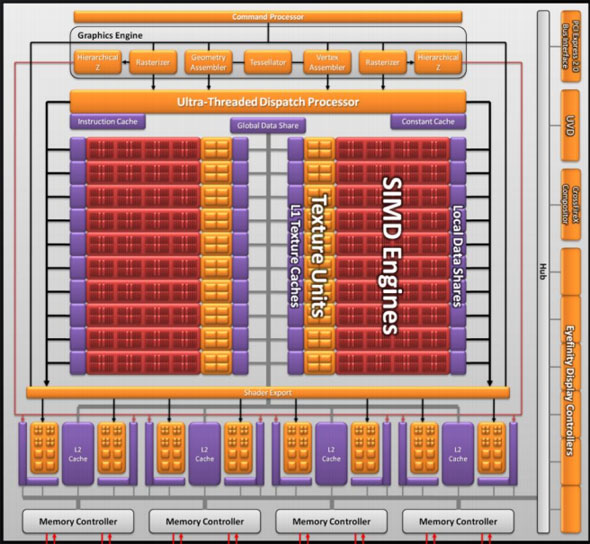
However with twice as many SIMDs, there comes a need to feed these additional SIMDs, and to do something with their products. To achieve this, the 4 L2 caches have been doubled from 64KB to 128KB. These large L2 caches can now feed data to L1 caches at 435GB/sec, up from 384GB/sec in RV770. Along with this the global data share has been quadrupled to 64KB.
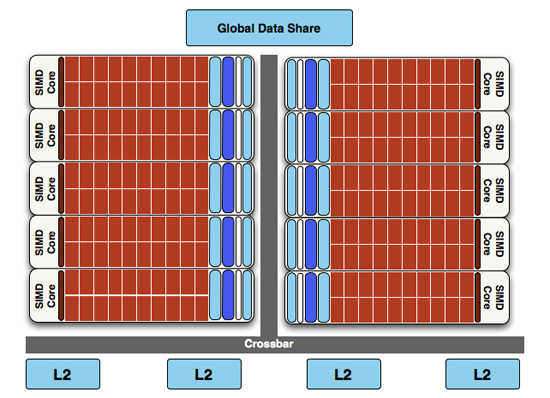
RV770 vs...
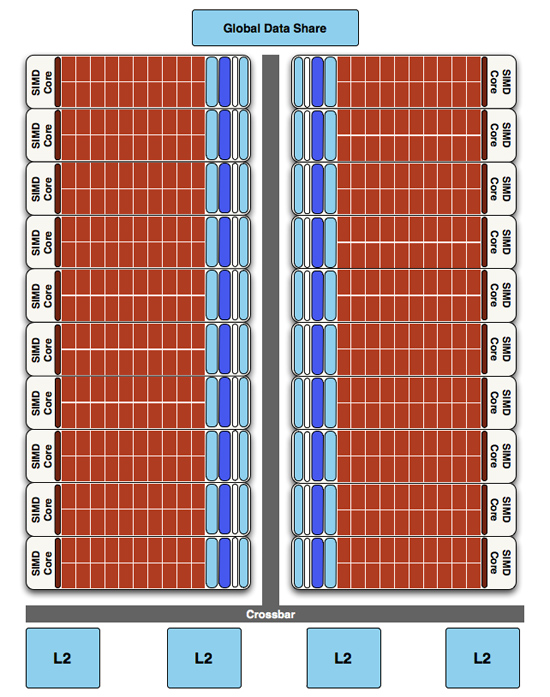
Cypress
Next up, the ROPs have been doubled in order to meet the needs of processing data from all of those SIMDs. This brings Cypress to 32 ROPs. The ROPs themselves have also been slightly enhanced to improve their performance; they can now perform fast color clears, as it turns out some games were doing this hundreds of times between frames. They are also responsible for handling some aspects of AMD’s re-introduced Supersampling Anti-Aliasing mode, which we will get to later.

Last, but certainly not least, we have the changes to what AMD calls the “graphics engine”, primarily to bring it into compliance with DX11. RV770’s greatly underutilized tessellator has been upgraded to full DX11 compliance, giving it Hull Shader and Domain Shader capabilities, along with using a newer algorithm to reduce tessellation artifacts. A second rasterizer has also been added, ostensibly to feed the beast that is the 20 SIMDs.










327 Comments
View All Comments
maomao0000 - Sunday, October 11, 2009 - link
http://www.myyshop.com">http://www.myyshop.comQuality is our Dignity; Service is our Lift.
Myyshop.com commodity is credit guarantee, you can rest assured of purchase, myyshop will
provide service for you all, welcome to myyshop.com
Air Jordan 7 Retro Size 10 Blk/Red Raptor - $34
100% Authentic Brand New in Box DS Air Jordan 7 Retro Raptor colorway
Never Worn, only been tried on the day I bought them back in 2002
$35Firm; no trades
http://www.myyshop.com/productlist.asp?id=s14">http://www.myyshop.com/productlist.asp?id=s14 (Jordan)
http://www.myyshop.com/productlist.asp?id=s29">http://www.myyshop.com/productlist.asp?id=s29 (Nike shox)
shaolin95 - Wednesday, October 7, 2009 - link
So Eyefinity may use 100 monitors but if we are still gaming on the flat plant then it makes no difference to me.Come on ATI, go with the real 3D games already..been waiting since the Radeon 64 SE days for you to get on with it.... :-(
GTX 295 for this boy as it is the only way to real 3D on a 60" DLP.
Nice that they have a fast product at good prices to keep the competition going. If either company goes down we all lose so support them both! :-)
Regards
raptorrage - Tuesday, October 6, 2009 - link
wow what a joke this review is but that i mean the reviewer stance on the 5870 sounds like he is a nvidia fan just because it like what 2-3fps off of the gtx 295 doesn't actually mean it can't catch that gpu as the driver updates come out and get the gpu to actually compete against that gpu and if i remember wasn't the GTX 295 the same when it came out .. its was good but it wasn't where we all thought it should have been then BAM a few months go by and it finds the performance it was missingi don't know if this was a fail on anandtech or the testing practices but i question them as i've read many other review sites and they had a clear view where the 5870 / GTX 295 where neck N neck as i've seen them first hand so i go ahead and state them here head 2 head @ 1920x1200 but at 2560x1600 the dual gpu cards do take the top slot but that is expected but it isn't as big as a margin as i see it.
and clearly he missed the whole point YES the 5870 dose compete with the GTX 295 i just believe your testing practices do come into question here because i've seen many sites where they didn't form the opinion that you have here it seems completely dismissive like AMD has failed i just don't see that in my opinion - I'll just take this review with a gain of salt as its completely meaningless
dieselcat18 - Saturday, October 3, 2009 - link
@Silicon DocNvidia fan-boy, troll, loser....take your gforce cards and go home...we can now all see how terrible ATi is thanks you ...so I really don't understand why people are beating down their doors for the 5800 series, just like people did for the 4800 and 3800 cards. I guess Nvidia fan-boy trolls like you have only one thing left to do and that's complain and cry like the itty-bitty babies that some of you are about the competition that's beating you like a drum.....so you just wait for your 300 series cards to be released (can't wait to see how many of those are available) so you can pay the overpriced premiums that Nvidia will be charging AGAIN !...hahaha...just like all that re-badging BS they pulled with the 9800 and 200 cards...what a joke !.. Oh my, I must say you have me in a mood and the ironic thing is I do like Nvidia as much as ATi, I currently own and use both. I just can't stand fools like you who spout nothing but mindless crap while waving your team flag (my card is better than your's..WhaaWhaaWhaa)...just take yourself along with your worthless opinions and slide back under that slimly rock you came from.
dieselcat18 - Saturday, October 3, 2009 - link
@Silicon DocNvidia fan-boy, troll, loser....take your gforce cards and go home...we can now all see how terrible ATi is thanks you ...so I really don't understand why people are beating down their doors for the 5800 series, just like people did for the 4800 and 3800 cards. I guess Nvidia fan-boy trolls like you have only one thing left to do and that's complain and cry like the itty-bitty babies that some of you are about the competition that's beating you like a drum.....so you just wait for your 300 series cards to be released (can't wait to see how many of those are available) so you can pay the overpriced premiums that Nvidia will be charging AGAIN !...hahaha...just like all that re-badging BS they pulled with the 9800 and 200 cards...what a joke !.. Oh my, I must say you have me in a mood and the ironic thing is I do like Nvidia as much as ATi, I currently own and use both. I just can't stand fools like you who spout nothing but mindless crap while waving your team flag (my card is better than your's..WhaaWhaaWhaa)...just take yourself along with your worthless opinions and slide back under that slimly rock you came from.
Scali - Thursday, October 1, 2009 - link
I have the GPU Computing SDK aswell, and I ran the Ocean test on my 8800GTS320. I got 40 fps, with the card at stock, with 4xAA and 16xAF on. Fullscreen or windowed didn't matter.How can your score be only 47 fps on the GTX285? And why does the screenshot say 157 fps on a GTX280?
157 fps is more along the lines of what I'd expect than 47 fps, given the performance of my 8800GTS.
Ryan Smith - Thursday, October 1, 2009 - link
Full screen, 2560x1600 with everything cranked up. At that resolution, it can be a very rough benchmark.The screenshot you're seeing is just something we took in windowed mode with the resolution turned way down so that we could fit a full-sized screenshot of the program in to our document engine.
Scali - Friday, October 2, 2009 - link
I've just checked the sourcecode and experimented a bit with changing some constants.The CS part always uses a dimension of 512, hardcoded, so not related to the screen size.
So the CS load is constant, the larger you make the window, the less you measure the GPGPU-performance, since it will become graphics-limited.
Technically you should make the window as small as possible to get a decent GPGPU-benchmark, not as large as possible.
Scali - Friday, October 2, 2009 - link
Hum, I wonder what you're measuring though.I'd have to study the code, see if higher resolutions increase only the onscreen polycount, or also the GPGPU-part of generating it.
Scali - Thursday, October 1, 2009 - link
That's 152 fps, not 257, sorry.